D Major
D Major scale for guitar.
The D Major is a seven-note scale. Notes are displayed in the fingerboard diagram with blue color with the root notes indicated by darker color. The root notes are always D tones. In the two-octave pattern, the first root note is on the 6th string, 10th fret.
D Major 2 octaves
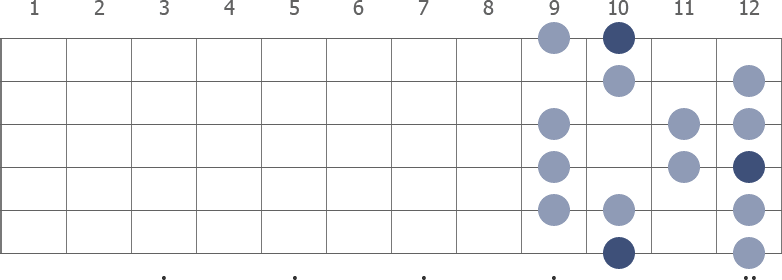
D Major full fretboard

D Major note names
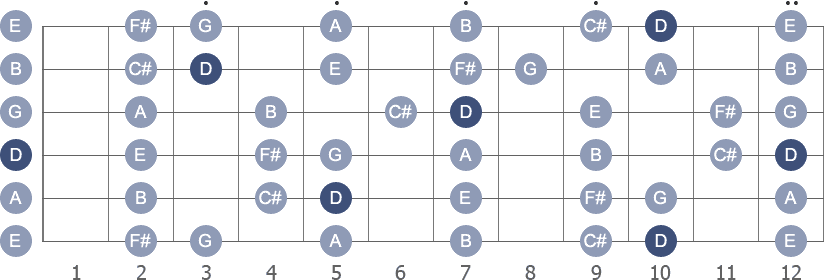
Shape 1 (9th position) with fingerings
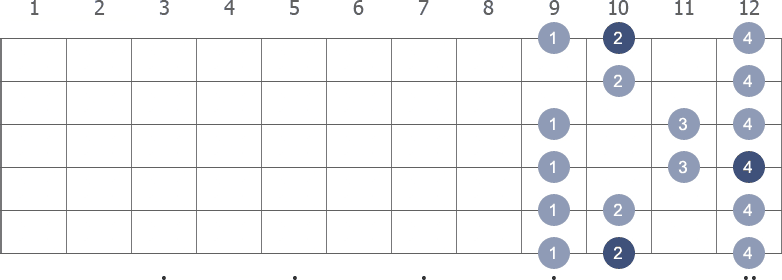
Shape 2 (12th position) with fingerings

Shape 3 (2nd position) with fingerings
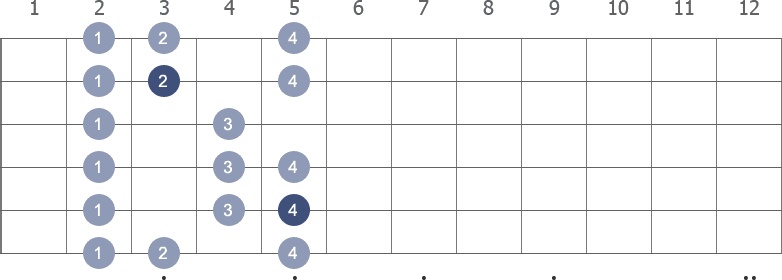
Shape 4 (4th position) with fingerings

Shape 5 (6th position) with fingerings
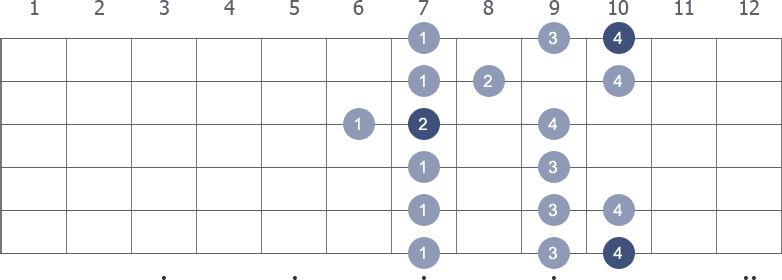
The scale displayed with its numeric formula and scale degrees.
| Formula | Notes | Intervals | Degrees |
|---|---|---|---|
| 1 | D | Unison | Tonic |
| 2 | E | Major second | Supertonic |
| 3 | F# | Major third | Mediant |
| 4 | G | Perfect fourth | Subdominant |
| 5 | A | Perfect fifth | Dominant |
| 6 | B | Sixth | Submediant |
| 7 | C# | Major seventh | Leading tone |
The interval formula (2 - 2 - 1 - 2 - 2 - 2 - 1) can be expound into specific notes of the scale.
| Notes (ascending) | Interval |
|---|---|
| D-E | M2 |
| D-F# | M3 |
| D-G | P4 |
| D-A | P5 |
| D-B | M6 |
| D-C# | M7 |
| Notes (descending) | Interval |
|---|---|
| D-C# | m2 |
| D-B | m3 |
| D-A | P4 |
| D-G | P5 |
| D-F# | m6 |
| D-E | m7 |
Abbreviations are used: M / m stands for major / minor and P stands for perfect.
The main three-note and four-note chords that are related to this scale are the following:
| Chord | Fingering | Chord | Fingering |
|---|---|---|---|
| D | XX0232 | Dmaj7 | XX0222 |
| Em | 022000 | Em7 | 022030 |
| F#m | 244222 | F#m7 | 242222 |
| G | 320003 | Gmaj7 | 320002 |
| A | X02220 | A7 | X02020 |
| Bm | X24432 | Bm7 | X20202 |
| C#dim | X4565X | C#m7b5 | X4545X |
The tones in these chords correspond to the tones of the D Major scale in which D is the tonic triad and Dmaj7 the tonic 7th chord.
The second and fourth columns include short notations for the chords in the first and third columns respectively. These are based on common ways to play the chord, but there are other alternatives. See more about this notation system on the FAQ page.
The D Major consists of seven notes (D - E - F# - G - A - B - C#). These can be described as intervals, as semi-notes or steps on the guitar fingerboard, written as 2 - 2 - 1 - 2 - 2 - 2 - 1 from the first note to the next octave.
The scale can be played on the guitar from different starting positions in which D functions as the tonic. It can be played in open position by starting from the open fourth string or in "full open position" by starting from the open low E string and continue to G on the highest string.
The D Major is relative to B Minor, which means that both scales include the same notes but with different tonal center.
The D Major is identical with the D Ionian mode.
The D Major scale has two accidentals: F# (F sharp) and C# (C sharp). Noticing these accidentals is one of the ways to memorize the scale.
Start the audio and play along with your guitar! Use notes from the scale in the diagram above.
Normal tempo:Three notes per string exercise based on D Major scale.

The numbers above the tablature are suggested fingerings.
The D scale presented in sheet music notation.

The sheet music includes two octaves played ascending and descending. In musical notation, the key of D is indicated by its key signature with two sharps.